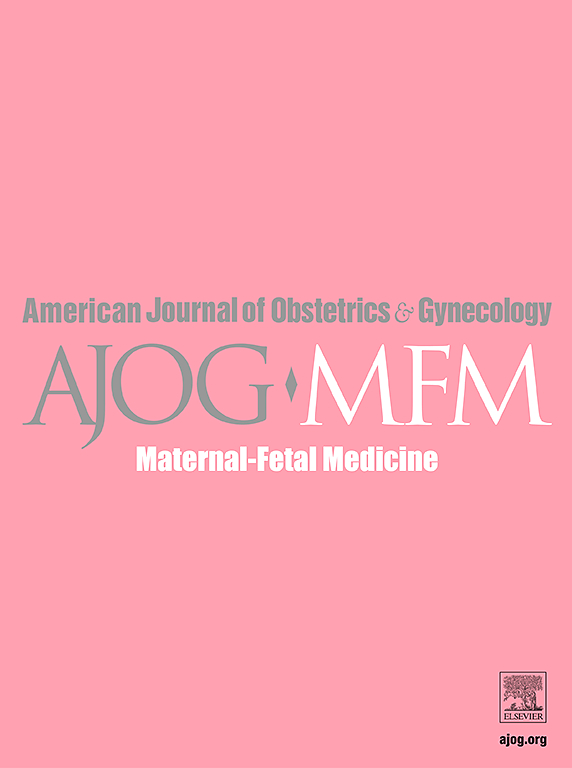Cerclage for short cervix ≤20 mm before 24 weeks in singleton gestations without prior spontaneous preterm birth decreases preterm birth: a meta-analysis of randomized controlled trials using individual patient-level data
IF 3.1
2区 医学
Q1 OBSTETRICS & GYNECOLOGY
American Journal of Obstetrics & Gynecology Mfm
Pub Date : 2025-08-18
DOI:10.1016/j.ajogmf.2025.101756
引用次数: 0
Abstract
Objective
To evaluate the efficacy of cervical cerclage in preventing preterm birth (PTB) in asymptomatic singleton pregnancies without prior spontaneous PTB and with a mid-trimester short transvaginal ultrasound cervical length (TVU CL).
Data Sources
MEDLINE, ClinicalTrials.gov, and the Cochrane Central Register of Controlled Trials were searched for the following terms: "cerclage," "cervical cerclage," "salvage," "rescue," "emergency," "ultrasound-indicated," "short cervix," "cervical length," "ultrasound," and "randomized trial," from inception of each database until November 2024. No language restrictions were applied.
Study eligibility criteria
We included all randomized controlled trials (RCTs) of asymptomatic singleton pregnancies without prior spontaneous PTB screened with TVU CL, found to have a midtrimester short CL ≤25.9 mm, and then randomized to management with either cerclage or no cerclage. We contacted corresponding authors of all the included trials to request access to the data and perform a meta-analysis of individual patient data.
Study appraisal and synthesis methods
Individual patient data from the original RCTs were merged into a master database specifically constructed for the review. The primary outcome was PTB <37 weeks. The summary measures were reported as relative risk (RR) or as mean difference (MD) with 95% confidence interval (CI). To obtain the pooled risk ratio estimate the random effects model of DerSimonian and Laird were used
Results
Six trials, including 507 asymptomatic singleton gestations without prior spontaneous PTB and with short mid-trimester TVU CL ≤25.9 mm, were included in the meta-analysis. The overall risk of bias of the included trials was judged as low. The primary outcome, PTB <37 weeks, occurred in 89/266 (33.5%) vs 96/241 (39.8%) in the cerclage vs no cerclage group, respectively (RR 0.88, 95% CI 0.59–1.31). Planned subgroup analyses revealed that in patients with CL ≤20.9 mm before 24 weeks, cerclage was associated with a significant decrease in PTB <37 weeks (56/181 (30.9%) vs 66/159 (41.5%); RR 0.75, 95% CI 0.56–0.99) and a significantly longer latency from randomization to delivery (P=.049).
Conclusions
In individuals with singleton gestations, without prior spontaneous PTB and with a short TVU CL in the second trimester, cerclage is associated with a significant decrease in PTB <37 weeks and a significant longer latency at TVU CL ≤20.9 mm before 24 weeks, but not an overall effect on TVU CL ≤25 mm.
无自发性早产的单胎妊娠24周前短宫颈≤20mm进行环扎术可减少早产:一项使用个体患者水平数据的随机对照试验的荟萃分析。
目的:探讨宫颈环扎术对无自发性PTB且妊娠中期经阴道超声宫颈长度短的无症状单胎妊娠预防早产(PTB)的效果。数据来源:MEDLINE、ClinicalTrials.gov和Cochrane Central Register of Controlled Trials检索了以下术语:“环切术”、“宫颈环切术”、“抢救”、“抢救”、“紧急”、“超声指示”、“短宫颈”、“宫颈长度”、“超声”和“随机试验”,从每个数据库建立到2024年11月。没有语言限制。研究资格标准:我们纳入了所有随机对照试验(RCTs):无自发性肺结核的无症状单胎妊娠,经TVU CL筛查,发现中期短CL≤25.9mm,然后随机分为环切术组和无环切术组。我们联系了所有纳入试验的通讯作者,要求查阅数据并对个体患者数据进行荟萃分析。研究评价和综合方法:来自原始rct的个体患者数据被合并到专门为本综述构建的主数据库中。结论:在单胎妊娠、既往无自发性PTB且妊娠中期TVU CL较短的个体中,环切术与< 37周的PTB显著降低以及24周前TVU CL≤20.9mm的潜伏期显著延长相关,但对TVU CL≤25mm的总体影响无关。
本文章由计算机程序翻译,如有差异,请以英文原文为准。
求助全文
约1分钟内获得全文
求助全文
来源期刊

American Journal of Obstetrics & Gynecology Mfm
Medicine-Medicine (all)
CiteScore
7.40
自引率
3.20%
发文量
254
审稿时长
40 days
期刊介绍:
The American Journal of Obstetrics and Gynecology (AJOG) is a highly esteemed publication with two companion titles. One of these is the American Journal of Obstetrics and Gynecology Maternal-Fetal Medicine (AJOG MFM), which is dedicated to the latest research in the field of maternal-fetal medicine, specifically concerning high-risk pregnancies. The journal encompasses a wide range of topics, including:
Maternal Complications: It addresses significant studies that have the potential to change clinical practice regarding complications faced by pregnant women.
Fetal Complications: The journal covers prenatal diagnosis, ultrasound, and genetic issues related to the fetus, providing insights into the management and care of fetal health.
Prenatal Care: It discusses the best practices in prenatal care to ensure the health and well-being of both the mother and the unborn child.
Intrapartum Care: It provides guidance on the care provided during the childbirth process, which is critical for the safety of both mother and baby.
Postpartum Issues: The journal also tackles issues that arise after childbirth, focusing on the postpartum period and its implications for maternal health. AJOG MFM serves as a reliable forum for peer-reviewed research, with a preference for randomized trials and meta-analyses. The goal is to equip researchers and clinicians with the most current information and evidence-based strategies to effectively manage high-risk pregnancies and to provide the best possible care for mothers and their unborn children.
 求助内容:
求助内容: 应助结果提醒方式:
应助结果提醒方式:


